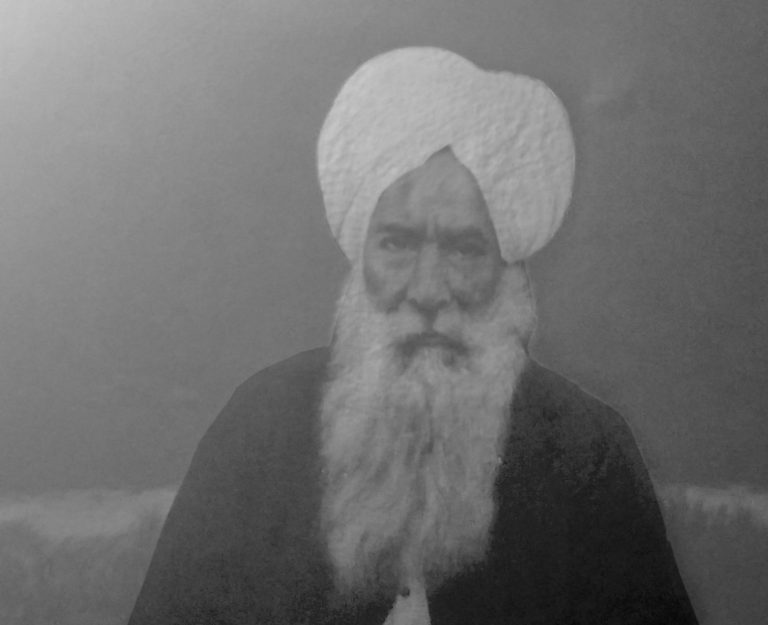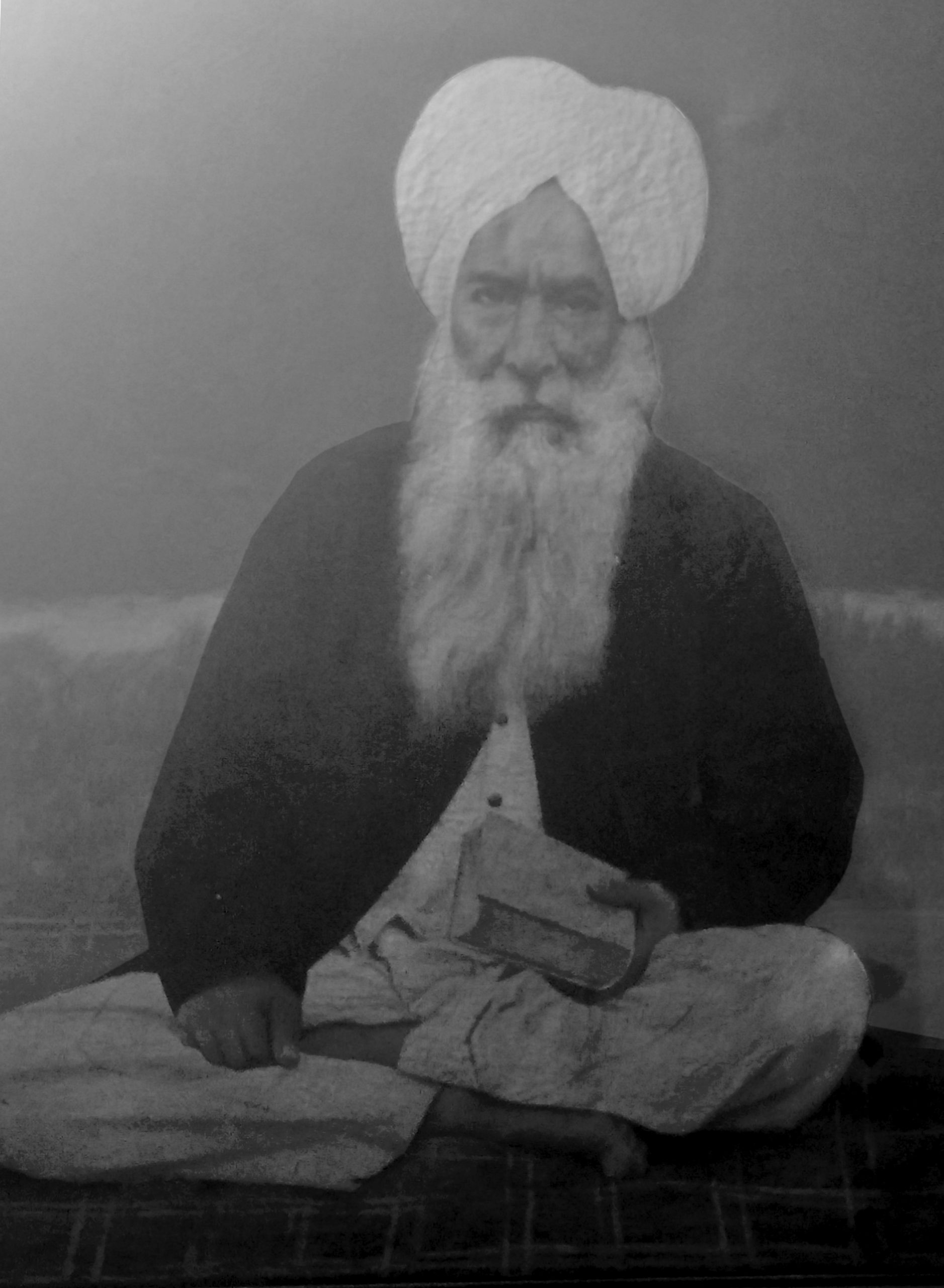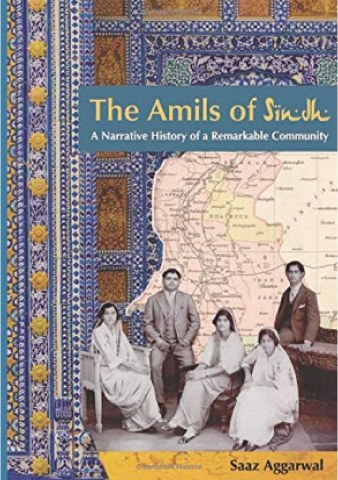
The portrait, Chinese lettering at the back of the canvas, was found from one of the boxes opened after the demise of Radhakrishna Advani, the grandson of Vasanmal
Saaz Aggarwal
Vasanmal was a professor and spiritual master. Being the eldest in his family, he was brought up as a Sikh and did not cut his hair, sporting a beard and turban. The book in his hand, his Sindhi translation of the Ramayana, was brought to Poona from Hyderabad along with this painting, but was misplaced.
 Vasanmal had one son, by name Tahilram, who worked in the postal department. Tahilram’s only son, Radhakrishna Advani, joined the Indian Medical Service and saw action in Italy during the First World War. Approaching middle age when the Second World War broke out, he opted for the Jail Department on the understanding that he would be back in uniform if ever needed. Joining the department as a junior officer, he rose to be Inspector General of Prisons of the Bombay Presidency and died while in service in 1948. In the years leading up to Partition he was stationed at the prestigious Yerwada Jail in Poona where his honored guests included Jawaharlal Nehru, Bal Gangadhar Tilak and others.
Vasanmal had one son, by name Tahilram, who worked in the postal department. Tahilram’s only son, Radhakrishna Advani, joined the Indian Medical Service and saw action in Italy during the First World War. Approaching middle age when the Second World War broke out, he opted for the Jail Department on the understanding that he would be back in uniform if ever needed. Joining the department as a junior officer, he rose to be Inspector General of Prisons of the Bombay Presidency and died while in service in 1948. In the years leading up to Partition he was stationed at the prestigious Yerwada Jail in Poona where his honored guests included Jawaharlal Nehru, Bal Gangadhar Tilak and others.
Less-known freedom fighters and prominent in their time, people like Sarojini Naidu and Mangal Das Pakvasa, while in jail, visited his home especially for the delicious meals his wife Lilan cooked. It was under Radhakrishna Advani’s watch that Mohandas Gandhi was incarcerated in the Aga Khan Palace, Poona and where his wife, Kasturba, died.
 Radhakrishna Advani died with a cerebral haemorrhage when he was just forty-eight years old. So at forty, Lilan (nee Mithi Chablani 1906) became a widow. Her husband had still been in office, and the government gave his family a flat in Poona. The family packed their things and many boxes of their belongings were kept in storage. After some years Lilan bought a flat in Shyam Niwas and moved to live there. As the boxes were taken out of storage, one was found to contain a portrait of Vasanmal, Radhakrishna’s grandfather, crushed and rather dirty. Lilan’s daughter, Sarla, took it to the curator of the National Museum in Delhi who helped her get it restored. Sarla found, to her surprise, Chinese lettering at the back of the canvas. The restorer explained that the portrait had been painted by a Chinese painter about a hundred years ago.
Radhakrishna Advani died with a cerebral haemorrhage when he was just forty-eight years old. So at forty, Lilan (nee Mithi Chablani 1906) became a widow. Her husband had still been in office, and the government gave his family a flat in Poona. The family packed their things and many boxes of their belongings were kept in storage. After some years Lilan bought a flat in Shyam Niwas and moved to live there. As the boxes were taken out of storage, one was found to contain a portrait of Vasanmal, Radhakrishna’s grandfather, crushed and rather dirty. Lilan’s daughter, Sarla, took it to the curator of the National Museum in Delhi who helped her get it restored. Sarla found, to her surprise, Chinese lettering at the back of the canvas. The restorer explained that the portrait had been painted by a Chinese painter about a hundred years ago.
Sarla married Jagdish Kumar, a Punjabi. Her brother Govind, an MBBS from Grant Medical College in Bombay first took up government service and later opened his own practice, Radhakrishna Dispensary (named in honour of his father), near Crawford Market. Her daughter married outside the community. Sarla and Govind’s brother, Bhagwan, died young leaving two daughters, one married to a non-Advani Amil. Mira, Govind’s wife, regrets the dying out of the Advani line.
[Excerpted from ‘The Amils of Sindh’ by Saaz Aggarwal]
____________________
 Saaz Aggarwal is an independent researcher, writer and artist based in Pune, India. Her body of writing includes biographies, translations, critical reviews and humor columns. Her books are in university libraries around the world, and much of her research contribution in the field of Sindh studies is easily accessible online. Her 2012 Sindh: Stories from a Vanished Homeland is an acknowledged classic. With an MSc from Mumbai University in 1982, Saaz taught undergraduate Mathematics at Ruparel College, Mumbai, for three years. She was appointed features editor at Times of India, Mumbai, in 1989.
Saaz Aggarwal is an independent researcher, writer and artist based in Pune, India. Her body of writing includes biographies, translations, critical reviews and humor columns. Her books are in university libraries around the world, and much of her research contribution in the field of Sindh studies is easily accessible online. Her 2012 Sindh: Stories from a Vanished Homeland is an acknowledged classic. With an MSc from Mumbai University in 1982, Saaz taught undergraduate Mathematics at Ruparel College, Mumbai, for three years. She was appointed features editor at Times of India, Mumbai, in 1989.
Courtesy: Saaz Aggarwal/Book ‘The Amils of Sindh’